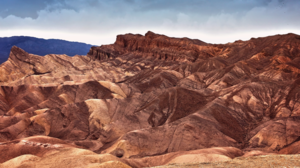by Robert Rollin

The first movement, “Sunrise,” began with exquisitely played French horn, flute, oboe, and English horn solos, supported by continuous parallel horn ostinatos. Crotales and chimes sparkled. Awe-inspiring film footage topped off earlier stills.
The Painted Desert was accompanied by brightly sunlit photos. Muted trumpets accompanied solo clarinets and English horn. Films of salamander and rabbit provided contrast.
On the Trail began with a gorgeous violin solo by concertmaster Rachel Stegman. Unlike the Disney, which used a slow-moving scorpion, Lias went for a literal connection with the donkey trains.
Grofé’s wonderful octave oboe leaps with woodblock accompaniment shone. Fine clarinet solos paired with black and white images of donkeys and riders. Pictures of cabins, resting riders, and steeds supported a lively piano solo. Old and color trail-ride films matched up with fuller ensemble textures.
Sunset began with strings and glockenspiel, soon joined by an enchanting oboe solo and triangle. Sunrise’s lovely descending horn solo returned, leading to chimes, muted trumpet, flutes, and another attractive Stegman solo.
The violin sections began Cloudburst in gentle counterpoint. Strings accompanied a beautiful English horn solo. Visuals displayed crisp snow scenes. The woodwinds echoed an appealing chromatic solo by principal cello Michael Gelfand.
Distant Thunder with Crickets Playing followed. Evocative bowed upper-string and piano glissandos joined with timpani and cymbals to depict lightening and thunder. The screen closed with a beautiful rainbow.
Strident trumpets, timpani, trombones and cymbals dominated John Williams’ Summon the Heroes. Low growling string basses introduced a tutti with glockenspiel, rumbling low bassoons, and snare drum racing to a final reprise.
Samuel Barber’s Essay No. 2 began with principal flute Kathryn Umble’s breathy low solo, answered gracefully by principal clarinet Alice Wang. Later violas, oboe, and French horn exchanged phrases, leading to a fast orchestral fugue nimbly introduced by Wang and answered by principal bassoon Ryan Finefrock.
After an intense snare drum solo followed by delicately soft strings, the orchestra ended with a powerful cadence. Though it was the most intricate of the evening’s pieces, the orchestra performed the Essay with great poise and concentration.
Aaron Copland’s Four Dance Episodes from Rodeo began with “Buckaroo Holiday” and a lively descending syncopated orchestra tune. Principal trombone John Gruber liltingly played the folk song, “I Bought me a Cat.”
The lyric “Corral Nocturne” encompassed muted brass, and expressive clarinet, oboe, and flute solos. “Saturday Night Waltz” featured plaintive French horn, oboe, and clarinet solos, quoting “Goodbye, Old Paint,” a sad folk song horse-and-rider dialogue.
The orchestra dashed through “Hoe-Down’s” square dances with verve. Brilliant trumpet, a low range piano solo, woodblock sounds, decorative xylophone, and snare drum rim shots, provided stunning coloration.
Published on ClevelandClassical.com November 13, 2017.
Click here for a printable copy of this article




